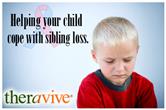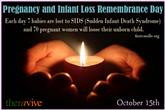January 16, 2014
by LuAnn Pierce, LCSW

The traumatic stresses that are likely to affect teens are interpersonal acts of violence, aggression or threats. This may be date rape, dating violence, bullying, harassment by a peer or adults, coercion or threats of violence, psychological and emotional blackmail and others.
[More]
October 27, 2013
by LuAnn Pierce, LCSW

Losing a pet may hurt your child much more than you realize...even that little pet lizard. Here are ways to not only help your child get through it, but guide them to growth.
[More]
October 20, 2013
by LuAnn Pierce, LCSW

Children process trauma much differently than we do. When a child loses a sibling, including the loss of a pregnancy, intervention is necessary. Here are ways you can help them cope.
[More]
October 15, 2013
by LuAnn Pierce, LCSW

The loss of a child is a pain no parent should ever know. For those who are on this journey, there are resources to help you, including some valuable community resources that parents should consider.
[More]
September 18, 2013
by LuAnn Pierce, LCSW

Resilience is a fundamental quality within us that determines how we respond to nearly every challenge in life. Some of it is hardwired, and some is not. Here are ways to build resilience in your child.
[More]
Elizabeth’s Story
I have known Elizabeth for a number of years. Outwardly she gives the impression of being a very quiet, gentle and passive woman. I had never heard her disagree with anyone. She is generous, fair minded and loving towards everyone.
She approached me a while back as she was receiving disturbing dreams and felt that her whole life was being shaken. She was experiencing a high degree of anxiety and depression. Her relationship with her husband was unfulfilling and her job as a nurse was not any better. All around she was in a desperate state. Her mother lived with her and that relationship was also confining. Physically her anxiety and stress manifested itself as a systemic yeast infection. She was extremely tired and had little energy and was fearful about what her dreams presented. I learned that Elizabeth’s background included an alcoholic father who had physically abused both her and her mother. She was an only daughter and a woman who never really became separated emotionally from her mother. Elizabeth never remembered disagreeing with her mother: she was a quiet, submissive child who grew into a quiet submissive woman.
There were two qualities which I deeply admired in her. Above and beyond all her pain, she was willing to commit herself to a long and arduous task of self discovery. It was her courage and determination to walk this narrow path and to become a better person which influenced my decision to become her companion along her journey. In the beginning she had many dreams of her childhood. It was as if she had to go back and relive her youth for the purpose of healing. She was invited to enter into her dreams and unlock whatever pain lived there. No moving forward could happen until she accomplished this process.
Our memories carry the burdens of the past which weigh heavily on the present. That is why it is so important to go back and discover the root of one’s pain. No real progress can be made unless past issues and conflicts are resolved. A purgation of the ego and persona and a stripping of its’ attachments are prerequisites for any movement towards the center of one’s true self. Old attitudes must be released and purified in order to clear the way for the journey inward and the discovery of one’s true self. Self-knowledge requires this intense confrontation with the darkness within.
The passage from the unknown to enlightenment demands discipline and great courage. As Elizabeth moved through the dreams of her childhood, much sadness was released through our work together. Active imagination and focusing with her body’s response to pain was part of the process of her healing. Experiencing the state of the child within was a powerful vehicle for the release of her suffering. Then one day she came to me with the following dream:
“My husband is raping me and I feel much oppression. In another room I hear a baby cry and I go to find it because it needs to be fed.”
We worked with the images from the dream. Elizabeth re-entered the dream and I asked her to be with and experience the feelings of oppressiveness and fear. After a while I asked her to remember times in her life when she felt very sure of herself; when she felt she was in control of her life and when she felt loved. With these positive feelings she replayed the dream, only this time she went to her husband and told him all that was in her heart. He started to cry and she realized he too was in pain. Then she focused on the baby and went to the room where the baby was crying. She picked her up and comforted her reassuring the baby that she would not abandon her again.
She placed the baby in a special place in her home. This represented for her a deep part of herself: an inner child which she had neglected, some innate potential which was associated with her power as a developing woman. In the dream, the baby was crying. In order for the baby to stop crying or in order for her to stop hurting, the baby had to be fed. In other words, Elizabeth had to take care of her own needs and she had to feed that which cried out from the depths of her spirit: her Self. She decided she would focus on trying to bring peace and order within herself rather than attempting to focus on her relationships around her. Peace begins within and Elizabeth agreed that if she would arrive at some ego strength and inner harmony, this would have an effect on her outer life.
A few weeks later she came to me with the following dream:
“ I am in a room; there are horses there and suddenly a woman enters the room. She has a gun and is pointing it at me. I am petrified.”
A horse is a powerful symbol of one’s life energy. The woman who is threatening Elizabeth with a symbol of power “the gun” is a part of her Shadow. When one attempts to integrate inner forces there is always resistance, for in a sense the forces must give up their power to the developing personality. In active imagination, I guided Elizabeth to the woman and asked her to befriend her. Elizabeth told her she needed her and her power to help her gain control of her life. After some time the woman, whom Elizabeth named Mira “after her own middle name” agreed to help. Then Mira helped Elizabeth ride one of the horses and although awkward she felt very good.
Then she had the following dream which frightened her to the point of tears:
“A dark, ugly, half human thing is in the corner of my room. I am so repulsed by this creature yet I realize it must be cared for. I place it in my bed and try to comfort it yet I can barely look at it as it is so horrible.”
Finally, that which was buried within the depths of her psyche was released into the light. Although she felt that she had slipped backwards, I knew this dream was a giant breakthrough for her healing. During the time we were working together she compared her life to a tunnel like place which was dark and constricting. It was as if Elizabeth was in a place of nowhere and she could no longer depend on the past securities yet she could not imagine a vision of where she was going.
This in between place is compared to a birth canal; Elizabeth was in a time of waiting, a time of transition and a time of the unknown. Now she had met her darkness, her shadow side which repulsed her. This half human creature symbolized all that she had formally denied. It comprised the feminine power of Mira, the anger at being put down by others whom which she had never made contact with and the underlying potential need for her developing personality. However ugly, Elizabeth realized it needed her to care for it and so she gave it a place of rest in her bed. She attempted to welcome it as part of her and in this act was the essence of transformation. Just as the princess who kisses the repulsive frog in the “The Frog Prince” gave life to a part of herself, so too Elizabeth gave life to herself in the integration of her Shadow.
As she stepped back into the dream, I asked her to move towards her creature. With great courage she looked into the monster and her fear changed as Elizabeth felt the creature was no longer threatening. It was full of sadness. She went to it – her – and embraced her and named her Mary. She promised she would never leave her again and never reject her own self.
The sadness thus represented that part of her true self that had been denied, raped or rejected by Elizabeth. Elizabeth realized that the violent figures she had dreamed of, such as the rapist, were part of her and she accepted the idea that she violated her own being in subtle ways as the dreams had shown. By embracing those aspects of herself, she began to integrate them slowly: a process which is part of a life long journey.
“A man has many skins in himself, covering the depths of his heart. Man knows so many other things; he does not know himself. Why, thirty or forty skins or hides, like an ox’s or a bear’s, so thick and hard, cover the soul. Go into your own ground and learn to know yourself.” – Meister Eckhart
August 19, 2013
by Ashley Marie

Bullying is a concern for parents, teachers, and children. And this challenge is becoming evermore complex as traditional bullying behaviours are taking new forms on the Internet.
School will be in session again.
Mothers are scanning flyers from department stores to snatch the latest deal on school supplies. Fathers are planning their morning and afternoon pick-up and drop-off schedules. Girls are picking out their outfit for the first day of school. Boys are gearing up for soccer tryouts.
And bullies are cracking their knuckles.
Bullying is no small challenge, and its harmful effects span across North America.
As discussed in the news this past week, Rehtaeh Parsons, a high school student in Nova Scotia, attempted suicide and passed away this year after a series of incidents of cyber bullying. The perpetrators distributed multiple photos of her online and physically raped her.
In Canada, 1 in 3 students are bullied during the academic year.[1] Sadly, of 35 countries that were studied internationally, Canada had the 9th highest rate of bullying for students at the age of 13.
In the United States, bullying has increased over the last decade.[2] Researchers estimate that 1 in 5 students are bullied over the course of an academic year, and 8% of students report to have bullied others.
Bullying Defined
Bullying involves a perpetrator who intends to harm its victim(s) emotionally and/or physically.[3] Moreover, it includes repeated incidents of emotional and/or physical aggression and is characterized by a power imbalance between two or more individuals.
According to the Canadian Council on Learning, bullying can be broken down into four broad categories: (1) physical bullying, (2) relational bullying, (3) verbal bullying, and (4) electronic bullying.[4] The last of these is a recent phenomenon that is becoming evermore dominant.
Cyber Bullying
Cyber bullying involves online forms of aggression, such as forwarding private photos or information of the victim or writing malicious comments directed at the victim on social networking sites.
Typically, there are more female than male victims of cyber bullying.
In Canada, 73% of victims of cyber bullying reported receiving aggressive emails or instant messages.[5]
In the United States, 1 in 5 teenagers has been cyber bullied and approximately the same number of teenagers have been a cyber bully.[6] Studies show that there is frequently a relationship between online and in-person bullying. Cyber bullying tends to contribute to social exclusion for female victims and tends to result in physical bullying for male victims.
It Often Starts At Home
Researchers have found that the issues that trigger bullying often stem from family dynamics at home.[7] Parents who do not provide a caring environment can harmfully affect their children, who in turn express their discontentment at school. Once the pain of life at home reaches a breaking point, children are more likely to act aggressively towards others.
It Usually Happens at School
Though the triggers that produce bullying behaviour tend to begin at home, the act of bullying typically occurs at school. Studies show that bullying occurs most prominently during recess and in the classroom.[8] Children commonly find their social life at school, so incidents of bullying are more likely to occur on school grounds.
In addition, bullies commonly seek a wider audience to which they can display their power over another. This is especially the case when teachers or supervisors are not present. For instance, schoolyards often lack sufficient supervision, making it easier for bullies to act aggressively towards their victim(s) without any punishment.
How Parents Can Help a Victim of Bullying
Though children do not always tell an adult about incidents of bullying, those who do tend to turn to their parents for help. In fact, 1 in 3 children turn to their mother or father.[9] This is a great time to asses how life for your child is in general- how is their self esteem etc. A Family Counselor can help to assist in communication with your children and working through issues you may not feel confident tackling.
But for those parents whose children have remained silent, these are some warning signs to look out for: unexplained scratches or bruises, unexplained damaged belongings, fear of walking to school or home from school, unpredictable mood swings, anxiety, poor academic performance, and having few friends.
How Parents Can Help a Perpetrator of Bullying
Once an incident of bullying has been identified, the family of the perpetrator of bullying should be notified. Because bullies commonly grow up in dysfunctional families, researchers recommend that schools involve their parents in the process of preventing future incidents of bullying. When parents must commit to actively helping their child, the positive result can be more sustainable in the long run. There are lots of stresses for Parents with back-to-school coming, to get some perspective on this read more here.
Increasing Awareness About Cyber Bullying
In the digital age that we live in, it is also important to help children navigate online social interactions. Social media sites and online forums are often the arena in which modern forms of bullying take place. Parents and teachers can educate children about proper online etiquette and inappropriate behavior. If the triggers of bullying behavior are stopped at home and in the classroom, then we can help decrease incidents of bullying overall.
[1] Canadian Bullying Statistics. 2012. Canadian Institutes of Health Research. [online] Available at: <http://www.cihr-irsc.gc.ca/e/45838.html>
[2] Bullying and Adolescent Health. 2011. Office of Adolescent Health. [online] Available at: <http://www.hhs.gov/ash/oah/news/e-updates/eupdate-7.html>
[3] Bullying in Canada. 2008. Canadian Council on Learning. [online] Available at: <http://www.ccl-cca.ca/pdfs/LessonsInLearning/Mar-20-08-Bullying-in-Canad.pdf>
[4] Ibid.
[5] Canadian Bullying Statistics. 2012. Canadian Institutes of Health Research. [online] Available at: <http://www.cihr-irsc.gc.ca/e/45838.html>
[6] Bullying and Adolescent Health. 2011. Office of Adolescent Health. [online] Available at: <http://www.hhs.gov/ash/oah/news/e-updates/eupdate-7.html>
[7] Rigby, K. 2007. Bullying in Schools and What to Do About It. Victoria, Australia: Acer Press.
[8] Ibid.
[9] Ibid.
In a matter of minutes, an entire community can be devastated by forces they cannot control. Whether it is natural or manmade, disasters are traumatic, and nearly everyone who experiences this kind of stress will need help coping with what they have experienced.
Traumatic Stress
Different types of natural disasters present different stress varying by how close the person is to the event. In some cases people will have trauma from loss, while others may feel guilt because they survived. Females tend to be more susceptible to trauma, but children and the elderly are the most susceptible to serious trauma. In all causes, the experience is an unexpected perceived brush with death.
Hurricanes- While hurricanes come with some warning, they also present stress in the wait to see if or where it will strike. This gives some preparation time, and time to gather things that are important, but extreme weather conditions such as thunder, lightning, rain and wind trigger panic reactions. People are left exhausted, and may suffer survivor guilt, and loss, in addition to injury.
Earthquake- Earthquakes are unpredictable, and do not have a defined end due to aftershocks. Lack of control combined with the fear of another quake can cause a person to have a heightened sense of fear. Sights and smells keep the person in a constant reminder state.
Tornado- Tornadoes give little to no time to prepare. For those who take refuge, not knowing what is happening, while hearing the sounds of destruction around them with no control over their situation is terrifying. Confusion is common. Destruction, sights and smells linger long after. In addition to loss, survivors may feel survivor guilt.
Flood- With floods come desolation of land. A sense that the earth is one thing that is stable is lost. Smell of wet, cold, mud and seeing the devastation of landscapes as well as infrastructure leaves an unstable feeling. Floods do not recede quickly, and cleanup may take a long time, creating exhaustion.
Wildfires- While fires often come with some warning, wind can change the course, and so many are unsure during the wait. Fire does not just ruin things, or remove them, it consumes them. Entire neighborhoods and communities can turn to ash, leaving people misplaced and vulnerable. [1]
Violence- Manmade disasters are unexpected, unfamiliar, and uncontrollable. For those who experience violence at the hands of another human being, trust in others can be lost, leaving them feeling unsafe, vulnerable, and often times, angry with a feeling that it should have been prevented. People may experience nightmares, and be reminded of their grief by seeing upsetting images, and experience upsetting thoughts for some time.
Consequences of Traumatic Stress
It is important for those who have experienced traumatic stress to understand that some of the feelings they experience are normal, and expected. The time it takes to see resilience will vary with the individual. Some common responses to traumatic stress may include:
Uncertainty- Mental and physical exhaustion, shock, disbelief, fear, helplessness, feeling a lack of control, loss of property, loved one, mementos, and income may result in feeling lost or numb. Pre-existing stresses resurface, or seem larger. Anniversaries of traumatic events may trigger the same feelings. Anger at God or others that the survivor may feel were responsible may also cause guilt.
Physical- Responses such as headaches, nausea, chest pain, and sleeplessness are common.
Relationship changes- Relations become tense, routines disrupted, and fear in losing loved ones may cause clinging in children, and tension in adults. Children may not fully understand what happened, and are put in a more responsible role. With their parents upset, children may feel they are still not safe. Children may feel lack of attention due to attention being placed on clean-up/repair. Parents may feel protective of their children and how they are processing the event.
Teens may revert to younger behavior.
Older people, who may suffer from previous health concerns, or have trouble hearing or seeing, may feel incompetent or a burden to the situation.
Work- Increased stress and disruptions in routines results in fatigue, inattention, conflict with others, reduced time available, reduced wages.
Financial- Destruction will change the standard of living. Unpaid bills may cause frustration and seeking financial assistance can add more stress. The financial burden for someone who was financially secure prior to the event will be less than for someone who was already burdened prior to the event.
First responders- While working long hours under intense stress over time, first responders witness human harm, and destruction. They may have their own injuries, depression, and PTSD. [2]
Resilience factors
Social support- Those who have communication and a culture of understanding tend to move more quickly toward emotional resilience.
Coping confidence- Sometimes knowing you will be ok, and that you can do it makes it easier to cope.
Hope- Looking at a positive future, and being able to see better things to come can make an impact on how the future will be for the survivor, and how quickly they feel better.
Therapy focuses on the resilience factors for those who feel overwhelmed by traumatic stress.
________________________________________________________________
[1] Lazarus, P. J., & Jimerson, S. R., Brock, S. E. (2002). Natural Disasters. In S. E. Brock, P. J. Lazarus, & S. R. Jimerson (Eds.), Best Practices in School Crisis Prevention and Intervention (pp. 435-450), Bethesda, MD: National Association of School Psychologists and other crisis information posted on the NASP website at www.nasponline.org.
[2] "Coping With a Traumatic Event." Emergency Preparedness and Response. CDC, 12 June 2003. Web. 06 July 2013